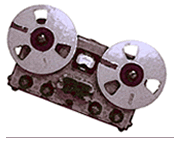


|
The sounds in the following piece, Chréode, by Jean-Baptiste Barrière, are based on something that all of us are familiar with: the sound of the singing human voice. All of the sounds in this piece are synthesized by a computer: there are no recordings of actual performers used. Instead, the computer simulates the method of vocal production and provides the composer with an array of parameters to control the synthesis. Barrière manipulates these different parameters to create a sonic texture that moves away and towards recognizable vocal sounds. To demonstrate the level of detail that Barrière worked at to shape the sounds of the piece back in 1983, I will be using a program that will represent graphically, in real-time, the frequency content of sound across time. The time axis runs top to bottom, the most recent events occurring towards the bottom, and the frequency axis runs from left to right, higher pitches or frequencies towards the right. Let's see what a series of vowels looks like in this representation: (image 1, three vowels; audio excerpt 1). Notice that each vowel has a different 'signature' that we can see visually, made up of different 'peaks' of loudness in different parts of the audible range. It is this arrangement of different elements that combine into an end result that we can categorize as 'a vocal sound,' and it is at this level of detail that Barri¸re is able to digitally manipulate the synthesis. All of these sonic 'signatures' are grouped, transformed and developed throughout the piece. In Chréode, Barrière uses computer-aided processes to direct how the sounds develop from one state to another. For example, one process might dictate the rhythmic activity of a particular section while another process governs the general trajectory of pitches. To demonstrate this I will use another representation of the frequency content of sound across time. This time the time axis scrolls to the left, while the frequency axis runs bottom to top, the higher frequencies towards the top. A very simple example of a process is an ascending glissando. Let's see how this is shown on the screen (image 2, audio excerpt 2). Notice that this representation is very similar to the previous one you've seen, but now it allows us to get a better sense of how a particular family of sounds change over time. As you listen to Chréode, feel free to look at--or ignore--these two representations (spectral representations run in real-time during performance).
|